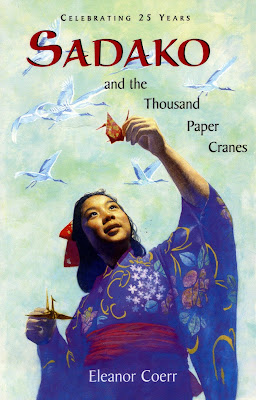Sadako was two years old when an atomic (nuclear) bomb was detonated over Hiroshima, Japan, near the end of World War II. As the story begins, Sadako is twelve years old, an athletic student who is close to her family and her best friend, believes in good luck symbols and is a fast runner who longs to make the school running team.
However, just as Sadako is running at her best, she notices dizziness and episodes of fatigue. She keeps her symptoms a secret, hoping they will disappear, until one day she collapses. Sadako is afraid she may have the atom bomb disease. Soon she is in hospital. Sadako has leukaemia, like so many others in her city who were affected by the radiation from the bomb.
In the hospital, Sadako's best friend brings her some paper and shows her how to fold a paper crane, and reminds Sadako of the old legend, if a sick person folds a thousand paper cranes, the gods will grant her wish and make her healthy again. Sadako begins to make paper cranes, throughout all her treatments and her ups and downs, and the number of cranes grow.
The story is told as a narrative, as if from Sadako's perspective. Whilst the author, Eleanor Coerr, would have imagined the conversations and some other aspects of the story, it is all based on extensive research into Sadako's life. Coerr lived in Japan for a number of years, where she first heard about the story of Sadako, and was able to obtain a copy of a rare book, called Kokeshi, which contained an autobiography written by Sadako and letters she wrote to her classmates during her illness.
Although Sadako had the best treatment that could be given at the time, she died from leukaemia. Today, when people have leukaemia, it is not usually from radiation like Sadako experienced, and many people recover after very intensive treatments, but this was not the situation in Sadako's era.
Sadako did not live long enough to make one thousand cranes but her classmates completed them for her and Sadako was buried with one thousand cranes. Three years after her death, a monument was built, of Sadako holding a crane, in Hiroshima Peace Park. It is known as the Children's Peace Monument and commemorates all the children who lost their lives and were affected for many years as a result of the bombing.
Such is the significance of this story, this book has been reprinted 39 times since 1977, sometimes with two or more reprints in a year. This story speaks to children and adults all over the world with its messages of hope, love and peace.
Title: Sadako and the Thousand Paper Cranes
Author: Eleanor Coerr
Publisher: Hachette Children's Books Australia, $12.99
Publication Date: 1 December 2002
Format: Paperback
ISBN: 9780733617324
For ages: 9+
Type: Narrative Non-Fiction

